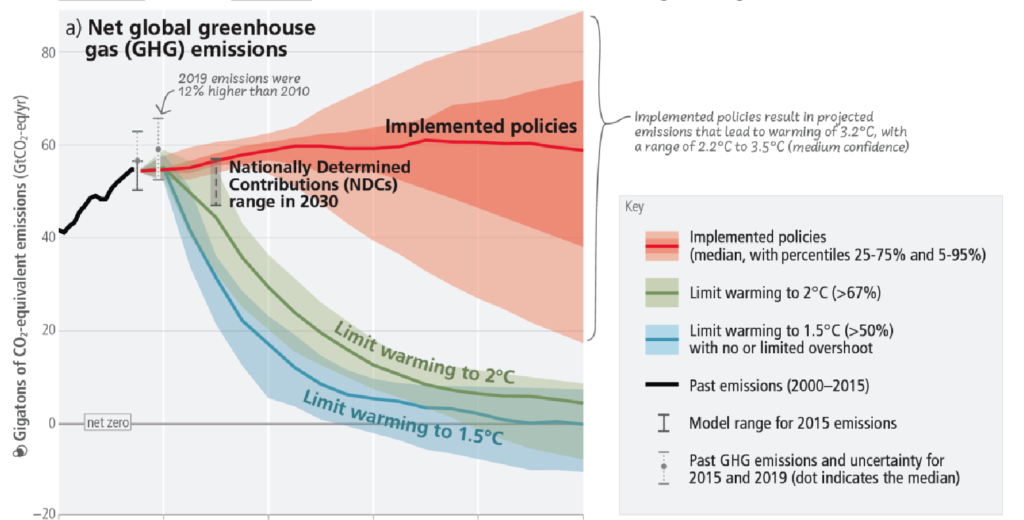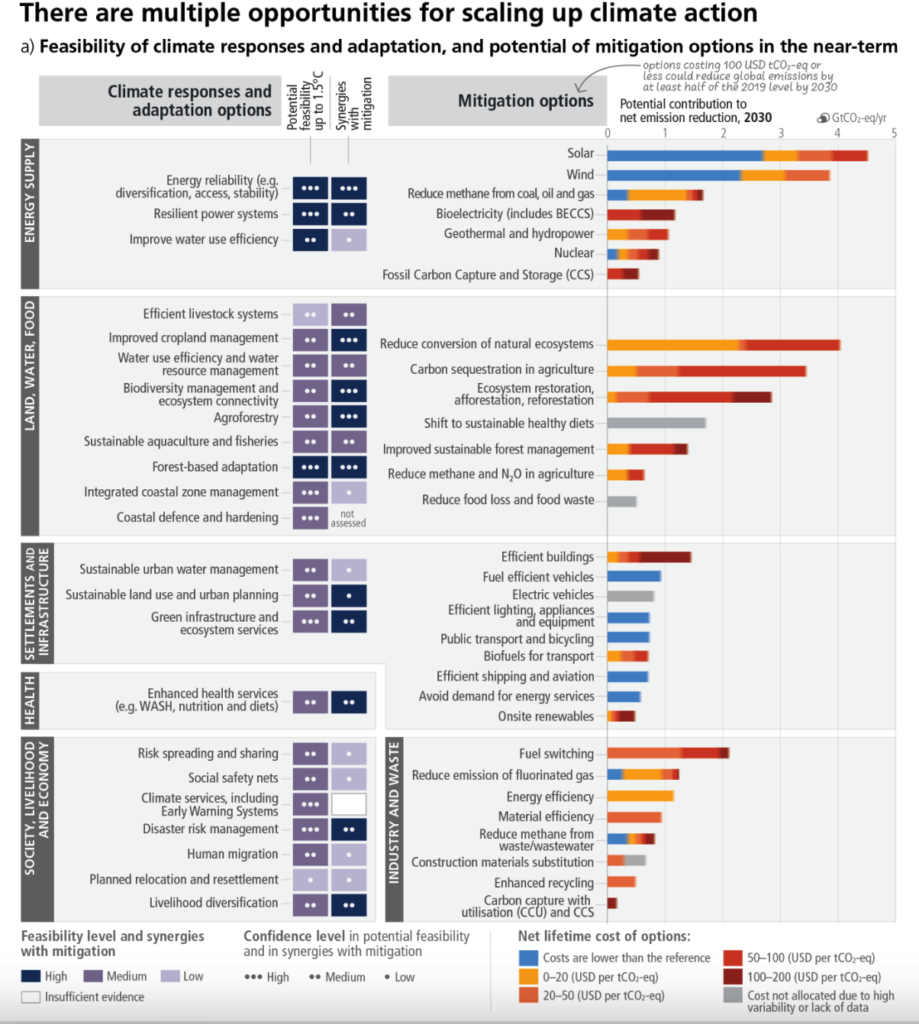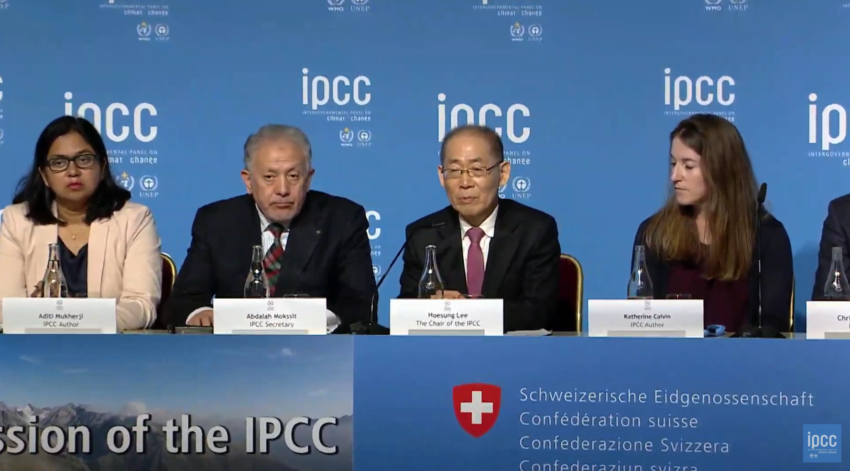This weekend the Synthesis Report was adopted in Interlaken, Switzerland, of 6 recent IPCC reports on science, impacts, mitigation, landuse and oceans. It is a summary agreed by governments that sums up what governments can do to prevent the worse effects of climate change. The Synthesis will also be used in this years’ climate summit CoP28 in Dubai, UAE in December. Parties will then Take Stock of the global progress so far to meet the Paris goals. Important will be to find ways to fill the gap toward 1,5 Degrees.
Global failure and Hope
Where are we now? Human activities, mainly burning fossil fuels, have already warmed the climate now by more than 1°C, causing severe impacts, mostly damaging the most vulnerable. “Almost half of the world’s population lives in regions that are highly vulnerable to climate change. In the last decade, deaths from floods, droughts and storms were 15 times higher in highly vulnerable regions“:Aditi Mukherji, IPCC Author said.
So, we need more adaptation action too, but that is only effective with mitigation. The 1,5 Degrees target gets out of reach soon. “We may pass 1,5 Degrees by 2035“: IPCC said in the press briefing. So, the rest of this decade is key to ger 50% reduction of global emissions by 2030.
But the most striking part of the Synthesis report is that hope remains, if we act faster and at larger scale. In the Q&A session IPCC says that “If we increase mitigation now, warming can stop in 20 years”. Good example in my view is the Global Methane Pledge to reduce methane by 30% by 2030. This could further limit warming by 0.2°-0.5° C in 2050. IPCC stressed that reductions and efficiency on demand side is promising. That could lead to 44% reduction by food, 67% with land transport, 66% by buildings, 66% by industry and 73% by electricity in 2050.

Cobenefits and Carbon Markets
New is also that climate action has also often valuable co-benefits: for human health, healthier cities, end of power poverty and ecosystem recovery. “Mainstreaming effective and equitable climate action will not only reduce losses and damages for nature and people, it will also provide wider benefits,” said IPCC Chair Hoesung Lee. “if we act now, we can still secure a liveable sustainable future for all.” And IPCC says from now on all growth and development should be “Climate Resilient”.
IPCC says that we need 3-6 times more finance for mitigation. I see a role for global carbon markets here, as that can generate an additional mitigation of more than 9 Gton/a in 2030 and help further close the gap. On carbon markets IPCC writes (C.6.4.):”Regulatory and economic instruments could support deep emissions reductions if scaled up and applied more widely. Where implemented, carbon pricing instruments have incentivized low-cost emissions reduction measures … and using revenue to support low-income households”.
SG Guterres: Increase targets further; zero by 2040 for developed countries
So, fast action on mitigation is needed and every degree lower helps. 1,7 where we may get with current plans now, is already better then 1,8 where we were first. The remaining budget for 1,5 degrees is around 400 gigaton. We have annual emissions 40 gigaton. During the press briefing UN SG Guterres said that “shipping, aviation, steel, cement, aluminum, agriculture – every sector, must be aligned with net zero by 2050 with clear plans including interim targets to get there”. And he asks developed countries to reach climate neutrality in 2040, helping global net zero in 2050. In the EU there are already voices to support this. Promising is that the EU ETS CO2 budget leads to zero already in 2039.
Role of Carbon Dioxide Removals
Carbon dioxide removal (CDR), says the Synthesis Report, will be necessary to achieve net-negative CO2 emissions after 2050. And it is unavoidable to counterbalance hard-to-abate residual emissions (from agriculture, aviation, shipping, and industrial processes) if net zero emissions are to be achieved. Limiting warming to 1.5C translates into around 6 GtCO2 of carbon dioxide removal (CDR) per year by 2050.
According to the Earth Negotiations Bulletin NGOs (CIEL) pushed to add that CDR ‘unproven and risky’ in order to prevent countries from using it. And France, Germany, Denmark initially agreed. But Saudi Arabia, China, New Zealand, Netherlands pushed to support CDR without those additions.
Indeed, between 1996 and 2020 only 0,2 gigaton was stored. So there are doubts whether the scale needed is feasible to be reached in time. The European Commission is working on a Carbon Removal Certification Framework system to store 310 Mton in soils and 5 Mton with BECCS in the EU in 2030. And only after that to get started with DAC.
What when we overshoot 1,5 Degrees? Turn down the heat!
If overshoot is 1,5 Degrees is feared what can be done to bring global temperatures down again below 1,5C Degrees:
- invest cutting short living gases like methane that lead to faster cooling.
- Also investing in measures that suck CO2 out of the atmosphere (forest, DAC),
- measures that cool the cities and regions (increase the albedo effect with whitening of clouds, roofs and buildings, plant more trees, arrange more green-blue infrastructure and
- prevent sun radiation (geoengineering). See also the report of the UN Overshoot Commission.

